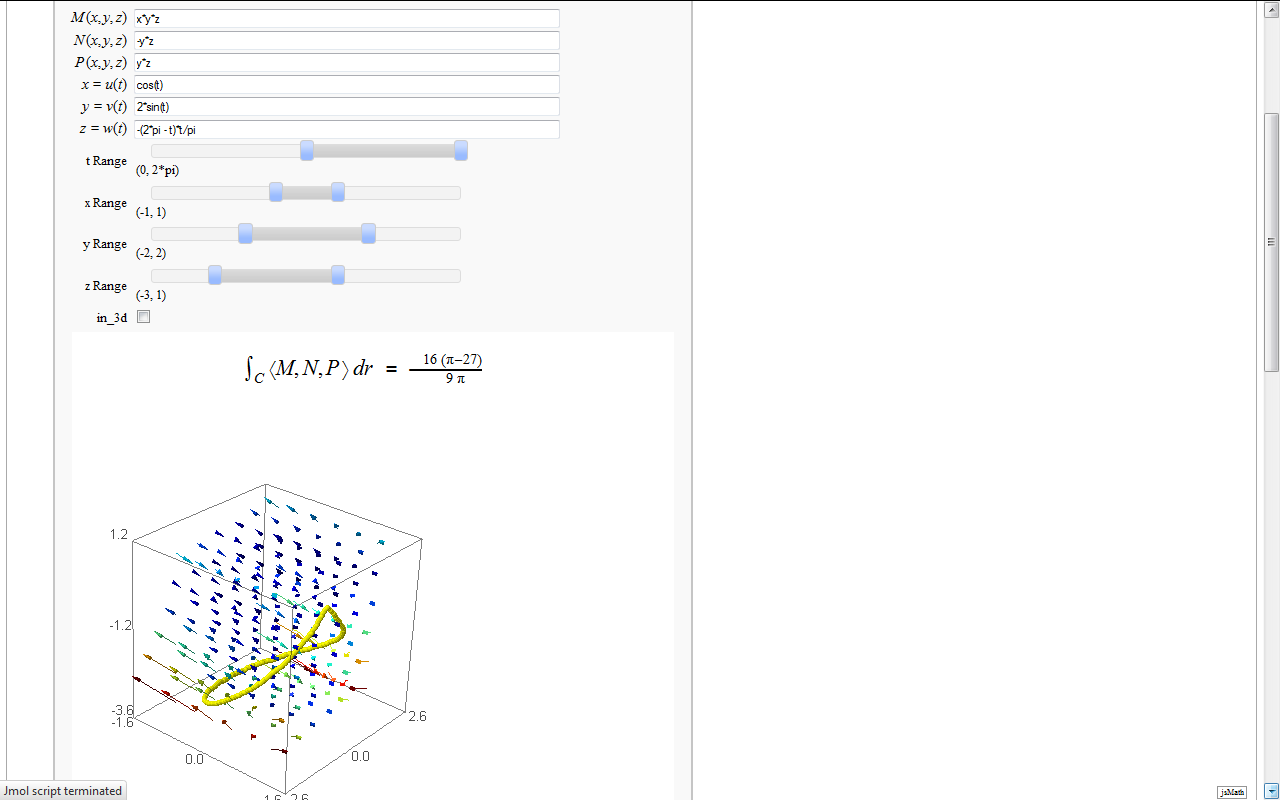|
Size: 59644
Comment:
|
Size: 62876
Comment: fix bug in Numerical integrals with various rules
|
| Deletions are marked like this. | Additions are marked like this. |
| Line 10: | Line 10: |
| [[http://aleph.sagemath.org/?z=eJytU02P2yAQvedXjCxFC4njJP06bOOqrdqe9hBVbS-rNMIY1ki2sQDvev99B5zYzq62l5aDPcDw5jHvkQsJmbKCu2MlXKFzImNgMWQxiMbS6xngcOaxD_yQkIJMjpJZd5SlZu5IZHLPjGJZKSyht5sDDcmi46Jx8Mk5o7LWia_GaDPiNMzaMFG1E-aelRaBbwmLM3roqz5oX8qXIK_oe89nmHtuIemhUKWAH6YVIzLHNMKWGV0jxMib-dOEIZLMQpj5kIeQ0yFPSWCZJZJT2Pma12CEa00NPB6pTrMlWyDKDjYjAz98ExEbf3xYF6XP5wsk8FI-Vskm-VZcZhmGYsEvVrZ9P2OIJFStdVCwewEMrLpDqgWr7wTSBVeIgTWQuY3nlkbz0OXxDudbJaxpRJ2TsE1nhatKEu2K7YcvukVxYW8EV1bpGr5r7eCbqnNV38FP67-fg4twc7fGExGdfQy4jLtZjiZDl_jbaUs6Civo0GWDmhva372fbWnwXkpWr2Oy2r5LktWW0pMVUauOprKPe0dsN78x6Fcag0Uh6jfmNpo_scullcGpSlzoiqf-8hpOVXtfjxpMAE_1p5LoptFWOdErw1yQBLvcaEy1oOWFRtGIZQv9QJpSu5EE16U26ZUR-RU2qatUnTL_Z1161vOJZU6EjNcrjaZeHLii-X2zDDZr-g7O-8qL6HW1AaAUNRnaNcneI8bLZMe8wj_OffKInIk3gg9VTShdA9kmbxeX-JODN3jQthUpVS3ILeFxsVDYBJKH4EBBagMKF3icU299UbeVpy4meHABuHyOuCrWb2gAwcnST_4Dcj5Fzv8FOXhiD0u4eSb_HxOSmYw%3D|Interact]] {{{ |
{{{#!sagecell |
| Line 30: | Line 29: |
| html("<h1>Double Precision Root Finding Using Bisection</h1>") @interact def _(f = cos(x) - x, a = float(0), b = float(1), eps=(-3,(-16..-1))): |
pretty_print(html("<h1>Double Precision Root Finding Using Bisection</h1>")) @interact def _(f = cos(x) - x, a = float(0), b = float(1), eps=(-3,(-16, -1))): |
| Line 36: | Line 35: |
| time c, intervals = bisect_method(f, a, b, eps) | c, intervals = bisect_method(f, a, b, eps) |
| Line 42: | Line 41: |
| print "f(c) = %r"%f(c) | print "f(c) = %r"%f(x=c) |
| Line 58: | Line 57: |
| [[http://aleph.sagemath.org/?z=eJx1U01v2zAMvedXEAGKUKvsxCm2QxsPG7Dt1A3BgJ2yNnAcOVZrS4akJG5-_WjZzhdWATYkPvKRfJTWIgMl9k6rZSlcrteYcUg5iMpyKJNaOmHiaDJh9wOgVUMMWbhLjExWhbDIFpMnD2SVkaXw6FoYuUuc3AmsmQedeWvDm7XxTssssW6ZFTpxy97No0cev_mvn6hTUTn46pyRq60T343R5irBwzWTh5tuEicsWRdpV7g2IEEqqE2iNgK7ntmRL0vJe4PpsUaZQbKymKUMZo1O92CE2xrVyNYn6H2b2BQCIhm39ZzzdL5hUlVCrXvkHbIBiY6jesT8IXdlgcNZHn3-prc0CZgbkUortYLfWjv4IdVaqg38sc3_lx_wyMJPP-LZmOKGbPBFqiZD6gZrugVLzKjY-nlK5U65r9zLjpPwI_MXIsbgjmMQfQrDIGJk8_G7pIhPjr1u5E4E0eQZade1TAIoB8MWurHDmzbs5OCagR34-ZjeuZuXjKZpOR5yOFyYM5K0yWQoE9bxoQtSZCuEwj7LJVdrJSGtZ1Qt6PW-CpgTT1Vo11SFNT8EvRxUx22_J5XMZpXqQpt4tCq2YtRF5xQ9D9_ouiF7gJfuJBV2-CNZ7LbEShMV4p6jCqKgVUwyNlYf8nNu7JGx4pNwSt8dwT7YyoOgJ8zgFv4eH4lfhVQCF8RNVPR_YU_8vNgkfR1xl8v0VQlrY6Jl7XPh--bBCLUtvSAnYbraba73OKd8jxxq6ik-16amluMzgf4Bb3xSAg%3D%3D|Interact]] http://sagenb.org/home/pub/2824/ {{{ |
https://cloud.sagemath.com/projects/19575ea0-317e-402b-be57-368d04c113db/files/pub/2801-2901/2824-Double%20Precision%20Root%20Finding%20Using%20Newton's%20Method.sagews {{{#!sagecell |
| Line 80: | Line 77: |
| html("<h1>Double Precision Root Finding Using Newton's Method</h1>") @interact def _(f = x^2 - 2, c = float(0.5), eps=(-3,(-16..-1)), interval=float(0.5)): |
pretty_print(html("<h1>Double Precision Root Finding Using Newton's Method</h1>")) @interact def _(f = x^2 - 2, c = float(0.5), eps=(-3,(-16, -1)), interval=float(0.5)): |
| Line 85: | Line 82: |
| time z, iterates = newton_method(f, c, eps) | z, iterates = newton_method(f, c, eps) |
| Line 90: | Line 87: |
| html(iterates) | pretty_print(html(iterates)) |
| Line 102: | Line 99: |
| [[http://aleph.sagemath.org/?z=eJx1UsFu4yAQvfcrkHpgSLBrO4pUVUJaqb-wN29qUYITujbYgJN4v34BO-3uoVzm8QYeb2b4obSXlgv_cJQtamAsGWQlhWxHd4RQNFZhX33uH1BaoucDqzGf_NRrTBF-N1rGKIzpljgM0kZ0snyO8Wx8Cu6C7ypp4Q-ZEoPSv1O0yvURuID0KaGp7xexa3KLD8HXxDvlZwZ7Wpd5_nwg5CXJ3uiMGLpwCzhATBLZBkq-QQZO6VDi5kbIW5WBMA7GajPHHXkcyyc3Wg9w25aBQFs0BzqEsbonspjYwrwt8n28k8SF0d5M1rG6oGVePFUFzXNaHpakYMJ0xoaGuTq2baV7J7tgqhYCGlK_7A6oNRY1SOlPveXkazi1Ms3QGQ8tRXCjYSZVGA_MdxRzzWBCgxwri83aH_rl7g7oMr3kgCZv79yyn3aSSznubK7wSlGrTk79kWxPEXeDFL6x3CvDyn-OxUd3x28s8SMfvLrIpB2NhKfWZ5Ge-iYRjnVSQ2LDXaWVV7xrjnLwZ7bWQP7zclHyKi3DnovzbPQ64PhXPMK_NM4_Qg8gVAjOW7oIk78OvNxY|Interact]] http://sagenb.org/home/pub/2823/ {{{ |
https://cloud.sagemath.com/projects/19575ea0-317e-402b-be57-368d04c113db/files/pub/2801-2901/2823.sagews {{{#!sagecell |
| Line 122: | Line 117: |
| {{{ html('<h2>Tangent line grapher</h2>') |
{{{#!sagecell pretty_print(html('<h2>Tangent line grapher</h2>')) |
| Line 130: | Line 125: |
| tanf = f(x0i) + df(x0i)*(x-x0i) | tanf = f(x=x0i) + df(x=x0i)*(x-x0i) |
| Line 134: | Line 129: |
| fmax = f.find_maximum_on_interval(prange[0], prange[1])[0] fmin = f.find_minimum_on_interval(prange[0], prange[1])[0] |
fmax = f.find_local_maximum(prange[0], prange[1])[0] fmin = f.find_local_minimum(prange[0], prange[1])[0] |
| Line 142: | Line 137: |
| {{{ | {{{#!sagecell |
| Line 151: | Line 146: |
| midys = [func(x_val) for x_val in midxs] | midys = [func(x=x_val) for x_val in midxs] |
| Line 157: | Line 152: |
| min_y = find_minimum_on_interval(func,a,b)[0] max_y = find_maximum_on_interval(func,a,b)[0] html('<h3>Numerical integrals with the midpoint rule</h3>') html('$\int_{a}^{b}{f(x) dx} {\\approx} \sum_i{f(x_i) \Delta x}$') |
min_y = min(0, find_local_minimum(func,a,b)[0]) max_y = max(0, find_local_maximum(func,a,b)[0]) pretty_print(html('<h3>Numerical integrals with the midpoint rule</h3>')) pretty_print(html('$\int_{a}^{b}{f(x) dx} {\\approx} \sum_i{f(x_i) \Delta x}$')) |
| Line 170: | Line 165: |
| {{{ # by Nick Alexander (based on the work of Marshall Hampton) |
{{{#!sagecell |
| Line 181: | Line 174: |
| t = sage.calculus.calculus.var('t') | t = var('t') |
| Line 195: | Line 188: |
| x = find_maximum_on_interval(func, q*dx + a, q*dx + dx + a)[1] | x = find_local_maximum(func, q*dx + a, q*dx + dx + a)[1] |
| Line 198: | Line 191: |
| x = find_minimum_on_interval(func, q*dx + a, q*dx + dx + a)[1] | x = find_local_minimum(func, q*dx + a, q*dx + dx + a)[1] |
| Line 209: | Line 202: |
| min_y = min(0, find_minimum_on_interval(func,a,b)[0]) max_y = max(0, find_maximum_on_interval(func,a,b)[0]) |
min_y = min(0, find_local_minimum(func,a,b)[0]) max_y = max(0, find_local_maximum(func,a,b)[0]) |
| Line 226: | Line 219: |
| html(r''' <div class="math"> \begin{align*} \int_{a}^{b} {f(x) \, dx} & = %s \\\ \sum_{i=1}^{%s} {f(x_i) \, \Delta x} & = %s \\\ & = %s \\\ & = %s . \end{align*} </div> ''' % (numerical_answer, number_of_subdivisions, sum_html, num_html, estimated_answer)) |
pretty_print(html(r''' <div class="math"> \begin{align*} \int_{a}^{b} {f(x) \, dx} & = %s \\\ \sum_{i=1}^{%s} {f(x_i) \, \Delta x} & = %s \\\ & = %s \\\ & = %s . \end{align*} </div>''' % (numerical_answer, number_of_subdivisions, sum_html, num_html, estimated_answer))) |
| Line 243: | Line 233: |
| {{{ | {{{#!sagecell |
| Line 247: | Line 237: |
| html('$r=' + latex(b+sin(a1*t)^n1 + cos(a2*t)^n2)+'$') | pretty_print(html('$r=' + latex(b+sin(a1*t)^n1 + cos(a2*t)^n2)+'$')) |
| Line 256: | Line 246: |
| {{{ | {{{#!sagecell |
| Line 334: | Line 324: |
| html('<center><font color="red">$f = %s$</font></center>'%latex(f)) html('<center><font color="green">$g = %s$</font></center>'%latex(g)) html('<center><font color="blue"><b>$h = %s = %s$</b></font></center>'%(lbl, latex(h))) |
pretty_print(html('<center><font color="red">$f = %s$</font></center>'%latex(f))) pretty_print(html('<center><font color="green">$g = %s$</font></center>'%latex(g))) pretty_print(html('<center><font color="blue"><b>$h = %s = %s$</b></font></center>'%(lbl, latex(h)))) |
| Line 354: | Line 344: |
| {{{ | {{{#!sagecell |
| Line 456: | Line 446: |
| == Coordinate Transformations == | == Coordinate Transformations (FIXME in Jupyter) == |
| Line 460: | Line 450: |
| {{{ | {{{#!sagecell |
| Line 462: | Line 452: |
| # polar coordinates #(x,y)=(u*cos(v),u*sin(v)); (u_range,v_range)=([0..6],[0..2*pi,step=pi/12]) # weird example (x,y)=(u^2-v^2,u*v+cos(u*v)); (u_range,v_range)=([-5..5],[-5..5]) thickness=4 square_length=.05 |
|
| Line 465: | Line 464: |
| def trans(x=input_box(u^2-v^2, label="x=",type=SR), \ y=input_box(u*v+cos(u*v), label="y=",type=SR), \ t_val=slider(0,10,0.2,6, label="Length of curves"), \ |
def trans(x=input_box(x, label="x",type=SR), y=input_box(y, label="y",type=SR), |
| Line 470: | Line 468: |
| u_range=input_box(range(-5,5,1), label="u lines"), v_range=input_box(range(-5,5,1), label="v lines")): thickness=4 u_val = min(u_range)+(max(u_range)-min(u_range))*u_percent v_val = min(v_range)+(max(v_range)-min(v_range))*v_percent t_min = -t_val t_max = t_val g1=sum([parametric_plot((i,v), (v,t_min,t_max), rgbcolor=(1,0,0)) for i in u_range]) g2=sum([parametric_plot((u,i), (u,t_min,t_max), rgbcolor=(0,0,1)) for i in v_range]) vline_straight=parametric_plot((u,v_val), (u,t_min,t_max), rgbcolor=(0,0,1), linestyle='-',thickness=thickness) uline_straight=parametric_plot((u_val, v), (v,t_min,t_max),rgbcolor=(1,0,0), linestyle='-',thickness=thickness) (g1+g2+vline_straight+uline_straight).save("uv_coord.png",aspect_ratio=1, figsize=[5,5], axes_labels=['$u$','$v$']) xuv = fast_float(x,'u','v') yuv = fast_float(y,'u','v') xvu = fast_float(x,'v','u') yvu = fast_float(y,'v','u') g3=sum([parametric_plot((partial(xuv,i),partial(yuv,i)), (v,t_min,t_max), rgbcolor=(1,0,0)) for i in u_range]) g4=sum([parametric_plot((partial(xvu,i),partial(yvu,i)), (u,t_min,t_max), rgbcolor=(0,0,1)) for i in v_range]) uline=parametric_plot((partial(xuv,u_val),partial(yuv,u_val)),(v,t_min,t_max),rgbcolor=(1,0,0), linestyle='-',thickness=thickness) vline=parametric_plot((partial(xvu,v_val),partial(yvu,v_val)), (u,t_min,t_max), rgbcolor=(0,0,1), linestyle='-',thickness=thickness) (g3+g4+vline+uline).save("xy_coord.png", aspect_ratio=1, figsize=[5,5], axes_labels=['$x$','$y$']) print jsmath("x=%s, \: y=%s"%(latex(x), latex(y))) print "<html><table><tr><td><img src='cell://uv_coord.png'/></td><td><img src='cell://xy_coord.png'/></td></tr></table></html>" |
t_val=slider(0,10,0.2,6, label="Length"), u_range=input_box(u_range, label="u lines"), v_range=input_box(v_range, label="v lines")): x(u,v)=x y(u,v)=y u_val = min(u_range)+(max(u_range)-min(u_range))*u_percent v_val = min(v_range)+(max(v_range)-min(v_range))*v_percent t_min = -t_val t_max = t_val uvplot=sum([parametric_plot((i,v), (v,t_min,t_max), color='red',axes_labels=['u','v'],figsize=[5,5]) for i in u_range]) uvplot+=sum([parametric_plot((u,i), (u,t_min,t_max), color='blue',axes_labels=['u','v']) for i in v_range]) uvplot+=parametric_plot((u,v_val), (u,t_min,t_max), rgbcolor=(0,0,1), linestyle='-',thickness=thickness) uvplot+=parametric_plot((u_val, v), (v,t_min,t_max),rgbcolor=(1,0,0), linestyle='-',thickness=thickness) pt=vector([u_val,v_val]) du=vector([(t_max-t_min)*square_length,0]) dv=vector([0,(t_max-t_min)*square_length]) uvplot+=polygon([pt,pt+dv,pt+du+dv,pt+du],color='purple',alpha=0.7) uvplot+=line([pt,pt+dv,pt+du+dv,pt+du],color='green') T(u,v)=(x,y) xuv = fast_float(x,'u','v') yuv = fast_float(y,'u','v') xvu = fast_float(x,'v','u') yvu = fast_float(y,'v','u') xyplot=sum([parametric_plot((partial(xuv,i),partial(yuv,i)), (v,t_min,t_max), color='red', axes_labels=['x','y'],figsize=[5,5]) for i in u_range]) xyplot+=sum([parametric_plot((partial(xvu,i),partial(yvu,i)), (u,t_min,t_max), color='blue') for i in v_range]) xyplot+=parametric_plot((partial(xuv,u_val),partial(yuv,u_val)),(v,t_min,t_max),color='red', linestyle='-',thickness=thickness) xyplot+=parametric_plot((partial(xvu,v_val),partial(yvu,v_val)), (u,t_min,t_max), color='blue', linestyle='-',thickness=thickness) jacobian=abs(T.diff().det()).simplify_full() t_vals=[0..1,step=t_val*.01] vertices=[(x(*c),y(*c)) for c in [pt+t*dv for t in t_vals]] vertices+=[(x(*c),y(*c)) for c in [pt+dv+t*du for t in t_vals]] vertices+=[(x(*c),y(*c)) for c in [pt+(1-t)*dv+du for t in t_vals]] vertices+=[(x(*c),y(*c)) for c in [pt+(1-t)*du for t in t_vals]] xyplot+=polygon(vertices,color='purple',alpha=0.7) xyplot+=line(vertices,color='green') pretty_print(html("$T(u,v)=%s$"%(latex(T(u,v))))) pretty_print(html("Jacobian: $%s$"%latex(jacobian(u,v)))) pretty_print(html("A very small region in $xy$ plane is approximately %0.4g times the size of the corresponding region in the $uv$ plane"%jacobian(u_val,v_val).n())) pretty_print(table([[uvplot,xyplot]])) |
| Line 502: | Line 517: |
| {{{ | {{{#!sagecell |
| Line 512: | Line 527: |
| html('$f(x)\;=\;%s$'%latex(f)) html('$\hat{f}(x;%s)\;=\;%s+\mathcal{O}(x^{%s})$'%(x0,latex(ft),order+1)) |
pretty_print(html('$f(x)\;=\;%s$'%latex(f))) pretty_print(html('$\hat{f}(x;%s)\;=\;%s+\mathcal{O}(x^{%s})$'%(x0,latex(ft),order+1))) |
| Line 525: | Line 540: |
| {{{ html("<h2>Limits: <i>ε-δ</i></h2>") html("This allows you to estimate which values of <i>δ</i> guarantee that <i>f</i> is within <i>ε</i> units of a limit.") html("<ul><li>Modify the value of <i>f</i> to choose a function.</li>") html("<li>Modify the value of <i>a</i> to change the <i>x</i>-value where the limit is being estimated.</li>") html("<li>Modify the value of <i>L</i> to change your guess of the limit.</li>") html("<li>Modify the values of <i>δ</i> and <i>ε</i> to modify the rectangle.</li></ul>") html("If the blue curve passes through the pink boxes, your values for <i>δ</i> and/or <i>ε</i> are probably wrong.") |
{{{#!sagecell pretty_print(html("<h2>Limits: <i>ε-δ</i></h2>")) pretty_print(html("This allows you to estimate which values of <i>δ</i> guarantee that <i>f</i> is within <i>ε</i> units of a limit.")) pretty_print(html("<ul><li>Modify the value of <i>f</i> to choose a function.</li>")) pretty_print(html("<li>Modify the value of <i>a</i> to change the <i>x</i>-value where the limit is being estimated.</li>")) pretty_print(html("<li>Modify the value of <i>L</i> to change your guess of the limit.</li>")) pretty_print(html("<li>Modify the values of <i>δ</i> and <i>ε</i> to modify the rectangle.</li></ul>")) pretty_print(html("If the blue curve passes through the pink boxes, your values for <i>δ</i> and/or <i>ε</i> are probably wrong.")) |
| Line 552: | Line 567: |
| {{{ | {{{#!sagecell |
| Line 556: | Line 571: |
| html('<h3>A graphical illustration of $\lim_{x -> 0} \sin(x)/x =1$</h3>') html('Below is the unit circle, so the length of the <font color=red>red line</font> is |sin(x)|') html('and the length of the <font color=blue>blue line</font> is |tan(x)| where x is the length of the arc.') html('From the picture, we see that |sin(x)| $\le$ |x| $\le$ |tan(x)|.') html('It follows easily from this that cos(x) $\le$ sin(x)/x $\le$ 1 when x is near 0.') html('As $\lim_{x ->0} \cos(x) =1$, we conclude that $\lim_{x -> 0} \sin(x)/x =1$.') |
pretty_print(html('<h3>A graphical illustration of $\lim_{x -> 0} \sin(x)/x =1$</h3>')) pretty_print(html('Below is the unit circle, so the length of the <font color=red>red line</font> is |sin(x)|')) pretty_print(html('and the length of the <font color=blue>blue line</font> is |tan(x)| where x is the length of the arc.')) pretty_print(html('From the picture, we see that |sin(x)| $\le$ |x| $\le$ |tan(x)|.')) pretty_print(html('It follows easily from this that cos(x) $\le$ sin(x)/x $\le$ 1 when x is near 0.')) pretty_print(html('As $\lim_{x ->0} \cos(x) =1$, we conclude that $\lim_{x -> 0} \sin(x)/x =1$.')) |
| Line 578: | Line 593: |
| {{{ | {{{#!sagecell |
| Line 593: | Line 608: |
| {{{ | {{{#!sagecell |
| Line 612: | Line 627: |
| sin,cos = math.sin,math.cos html("<h1>The midpoint rule for a function of two variables</h1>") |
pretty_print(html("<h1>The midpoint rule for a function of two variables</h1>")) |
| Line 628: | Line 643: |
| html("$$\int_{"+str(R16(y_start))+"}^{"+str(R16(y_end))+"} "+ "\int_{"+str(R16(x_start))+"}^{"+str(R16(x_end))+"} "+func+"\ dx \ dy$$") html('<p style="text-align: center;">Numerical approximation: ' + str(num_approx)+'</p>') |
pretty_print(html("$$\int_{"+str(R16(y_start))+"}^{"+str(R16(y_end))+"} "+ "\int_{"+str(R16(x_start))+"}^{"+str(R16(x_end))+"} "+func+"\ dx \ dy$$")) pretty_print(html('<p style="text-align: center;">Numerical approximation: ' + str(num_approx)+'</p>')) |
| Line 639: | Line 654: |
| {{{ from scipy.special.orthogonal import p_roots |
{{{#!sagecell import scipy import numpy from scipy.special.orthogonal import p_roots, t_roots, u_roots |
| Line 649: | Line 666: |
| 'Chebyshev': {'w': 1/sqrt(1-x**2), 'xmin': -1, 'xmax': 1, 'func': t_roots}, 'Chebyshev2': {'w': sqrt(1-x**2), 'xmin': -1, 'xmax': 1, 'func': u_roots}, 'Trapezoid': {'w': 1, 'xmin': -1, 'xmax': 1, 'func': lambda n: (linspace(-1r,1,n), numpy.array([1.0r]+[2.0r]*(n-2)+[1.0r])*1.0r/n)}, 'Simpson': {'w': 1, 'xmin': -1, 'xmax': 1, 'func': lambda n: (linspace(-1r,1,n), numpy.array([1.0r]+[4.0r,2.0r]*int((n-3.0r)/2.0r)+[4.0r,1.0r])*2.0r/(3.0r*n))}} |
'Chebyshev': {'w': 1/sqrt(1-x**2), 'xmin': -1, 'xmax': 1, 'func': t_roots}, 'Chebyshev2': {'w': sqrt(1-x**2), 'xmin': -1, 'xmax': 1, 'func': u_roots}, 'Trapezoid': {'w': 1, 'xmin': -1, 'xmax': 1, 'func': lambda n: (linspace(-1r,1,n), numpy.array([1.0r]+[2.0r]*(n-2)+[1.0r])*1.0r/n)}, 'Simpson': {'w': 1, 'xmin': -1, 'xmax': 1, 'func': lambda n: (linspace(-1r,1,n), numpy.array([1.0r]+[4.0r,2.0r]*int((n-3.0r)/2.0r)+[4.0r,1.0r])*2.0r/(3.0r*n))}} |
| Line 656: | Line 676: |
| return polygon([(center-width2,0),(center+width2,0),(center+width2,height),(center-width2,height)],**kwds) | return polygon([(center-width2,0), (center+width2,0),(center+width2,height),(center-width2,height)],**kwds) |
| Line 660: | Line 681: |
| def weights(n=slider(1,30,1,default=10),f=input_box(default=3*x+cos(10*x)),show_method=["Legendre", "Chebyshev", "Chebyshev2", "Trapezoid","Simpson"]): | def weights(n=slider(1,30,1,default=10),f=input_box(default=3*x+cos(10*x),type=SR), show_method=["Legendre", "Chebyshev", "Chebyshev2", "Trapezoid","Simpson"]): |
| Line 669: | Line 691: |
| scaled_ff = fast_float(scaled_func) | scaled_ff = fast_float(scaled_func, 'x') |
| Line 677: | Line 699: |
| stems = sum(line([(x,0),(x,scaled_ff(x))],rgbcolor=(1-y,1-y,1-y),thickness=2,markersize=6,alpha=y) for x,y in coords_scaled) points = sum([point([(x,0),(x,scaled_ff(x))],rgbcolor='black',pointsize=30) for x,_ in coords]) |
stems = sum(line([(x,0),(x,scaled_ff(x))],rgbcolor=(1-y,1-y,1-y), thickness=2,markersize=6,alpha=y) for x,y in coords_scaled) points = sum([point([(x,0), (x,scaled_ff(x))],rgbcolor='black',pointsize=30) for x,_ in coords]) |
| Line 683: | Line 707: |
| show(graph,xmin=plot_min,xmax=plot_max) | show(graph,xmin=plot_min,xmax=plot_max,aspect_ratio="auto") |
| Line 691: | Line 715: |
| html("$$\sum_{i=1}^{i=%s}w_i\left(%s\\right)= %s\\approx %s =\int_{-1}^{1}%s \,dx$$"%(n,latex(f.subs(x="x_i")), approximation, integral, latex(scaled_func))) | pretty_print(html("$$\sum_{i=1}^{i=%s}w_i\left(%s\\right)= %s\\approx %s =\int_{-1}^{1}%s \,dx$$"%(n, latex(f), approximation, integral, latex(scaled_func)))) |
| Line 704: | Line 729: |
| {{{ | {{{#!sagecell |
| Line 735: | Line 760: |
| velocity = derivative( position(t) ) acceleration = derivative(velocity(t)) |
velocity = derivative(position(t), t) acceleration = derivative(velocity(t), t) |
| Line 738: | Line 763: |
| speed_deriv = derivative(speed) | speed_deriv = derivative(speed, t) |
| Line 740: | Line 765: |
| dT = derivative(tangent(t)) | dT = derivative(tangent(t), t) |
| Line 811: | Line 836: |
| == Vector Calculus, 3-D Motion == | == Vector Calculus, 3-D Motion (FIXME) == |
| Line 816: | Line 841: |
| {{{ | {{{#!sagecell |
| Line 853: | Line 878: |
| velocity = derivative( position(t) ) acceleration = derivative(velocity(t)) |
velocity = derivative( position(t), t) acceleration = derivative(velocity(t), t) |
| Line 856: | Line 881: |
| speed_deriv = derivative(speed) | speed_deriv = derivative(speed, t) |
| Line 858: | Line 883: |
| dT = derivative(tangent(t)) | dT = derivative(tangent(t), t) |
| Line 861: | Line 886: |
| ## dB = derivative(binormal(t)) | ## dB = derivative(binormal(t), t) |
| Line 942: | Line 967: |
| http://www.sagenb.org/home/pub/2828/ {{{ |
http://sagenb.mc.edu/home/pub/97/ {{{#!sagecell |
| Line 952: | Line 977: |
| ## An updated version of this worksheet may be available at http://sagenb.mc.edu | |
| Line 957: | Line 981: |
| var('x,y,z') Rmin=1/10 |
|
| Line 959: | Line 984: |
| @interact def _(f=input_box(default=(x^3-y^3)/(x^2+y^2)),R=slider(0.1/10,Rmax,1/10,2),x0=(0),y0=(0)): |
@interact(layout=dict(top=[['f'],['x0'],['y0']], bottom=[['in_3d','curves','R','graphjmol']])) def _(f=input_box((x^2-y^2)/(x^2+y^2),width=30,label='$f(x)$'), R=slider(Rmin,Rmax,1/10,Rmax,label=', $R$'), x0=input_box(0,width=10,label='$x_0$'), y0=input_box(0,width=10,label='$y_0$'), curves=checkbox(default=false,label='Show curves'), in_3d=checkbox(default=false,label='3D'), graphjmol=checkbox(default=true,label='Interactive graph')): if graphjmol: view_method = 'jmol' else: view_method = 'tachyon' |
| Line 968: | Line 1004: |
| Line 970: | Line 1006: |
| limit = plot3d(g,(t,0,2*pi),(r,1/100,R),transformation=cylinder,rgbcolor=(0,1,0)) | collapsing_surface = plot3d(g,(t,0,2*pi),(r,1/100,R),transformation=cylinder,rgbcolor=(0,1,0)) |
| Line 972: | Line 1008: |
| show(surface+limit) print html('Enter $(x_0 ,y_0 )$ above and see what happens as R approaches zero.') print html('The surface has a limit as $(x,y)$ approaches ('+str(x0)+','+str(y0)+') if the green region collapses to a point') |
G = surface+collapsing_surface pretty_print(html('Enter $(x_0 ,y_0 )$ above and see what happens as $ R \\rightarrow 0 $.')) pretty_print(html('The surface has a limit as $(x,y) \\rightarrow $ ('+str(x0)+','+str(y0)+') if the green region collapses to a point.')) # If checked, add a couple of curves on the surface corresponding to limit as x->x0 for y=x^(3/5), # and as y->y0 for x=y^(3/5). Should make this more robust but perhaps using # these relatively obtuse curves could eliminate problems. if curves: curve_x = parametric_plot3d([x0-t,y0-t^(3/5),f(x=x0-t,y=y0-t^(3/5))],(t,Rmin,Rmax),color='red',thickness=10) curve_y = parametric_plot3d([x0+t^(3/5),y0+t,f(x=x0+t^(3/5),y=y0+t)],(t,Rmin,Rmax),color='red',thickness=10) R2 = Rmin/4 G += arrow((x0-Rmin,y0-Rmin^(3/5),f(x=x0-Rmin,y=y0-Rmin^(3/5))),(x0-R2,y0-R2^(3/5),f(x=x0-R2,y=y0-R2^(3/5))),size=30 ) G += arrow((x0+Rmin^(3/5),y0+Rmin,f(x=x0+Rmin^(3/5),y=y0+Rmin)),(x0+R2^(3/5),y0+R2,f(x=x0+R2^(3/5),y=y0+R2)),size=30 ) limit_x = limit(f(x=x0-t,y=y0-t^(3/5)),t=0) limit_y = limit(f(x=x0+t^(3/5),y=y0+t),t=0) text_x = text3d(limit_x,(x0,y0,limit_x)) text_y = text3d(limit_y,(x0,y0,limit_y)) G += curve_x+curve_y+text_x+text_y pretty_print(html('The red curves represent a couple of trajectories on the surface. If they do not meet, then')) pretty_print(html('there is also no limit. (If computer hangs up, likely the computer can not do these limits.)')) pretty_print(html('\n<center><font color="red">$\lim_{(x,?)\\rightarrow(x_0,y_0)} f(x,y) =%s$</font>'%str(limit_x)+' and <font color="red">$\lim_{(?,y)\\rightarrow(x_0,y_0)} f(x,y) =%s$</font></center>'%str(limit_y))) if in_3d: show(G,stereo="redcyan",viewer=view_method) else: show(G,perspective_depth=true,viewer=view_method) |
| Line 979: | Line 1042: |
| {{{ | {{{#!sagecell |
| Line 996: | Line 1060: |
| Rmax=2 @interact def _(f=input_box(default=(x^3-y^3)/(x^2+y^2)), N=slider(5,100,1,10,label='Number of Contours'), x0=(0),y0=(0)): print html('Enter $(x_0 ,y_0 )$ above and see what happens as the number of contour levels increases.') print html('A surface will have a limit in the center of this graph provided there is not a sudden change in color there.') |
var('x,y,z,u') @interact(layout=dict(top=[['f'],['x0'],['y0']], bottom=[['N'],['R']])) def _(f=input_box(default=(x*y^2)/(x^2+y^4),width=30,label='$f(x)$'), N=slider(5,100,1,10,label='Number of Contours'), R=slider(0.1,1,0.01,1,label='Radius of circular neighborhood'), x0=input_box(0,width=10,label='$x_0$'), y0=input_box(0,width=10,label='$y_0$')): pretty_print(html('Enter $(x_0 ,y_0 )$ above and see what happens as the number of contour levels $\\rightarrow \infty $.')) pretty_print(html('A surface will have a limit in the center of this graph provided there is not a sudden change in color there.')) # Need to make certain the min and max contour lines are not huge due to asymptotes. If so, clip and start contours at some reasonable # values so that there are a nice collection of contours to show around the desired point. |
| Line 1006: | Line 1076: |
| surface += parametric_plot([R*cos(u),R*sin(u)],[0,2*pi],color='black') # Nice to use if f=x*y^2/(x^2 + y^4) # var('u') # surface += parametric_plot([u^2,u],[u,-1,1],color='black') |
|
| Line 1007: | Line 1081: |
| show(limit_point+surface)}}} | # show(limit_point+surface) pretty_print(table([[surface],['hi']])) }}} |
| Line 1016: | Line 1092: |
| {{{ | {{{#!sagecell |
| Line 1069: | Line 1145: |
| {{{ %hide %auto |
{{{#!sagecell |
| Line 1086: | Line 1160: |
| html(r'Function $ f(x,y)=%s$ '%latex(f(x,y))) | pretty_print(html(r'Function $ f(x,y)=%s$ '%latex(f(x,y)))) |
| Line 1100: | Line 1174: |
| html(r'<tr><td>$\quad f(%s,%s)\quad $</td><td>$\quad %s$</td>\ </tr>'%(latex(x0),latex(y0),z0.n())) |
pretty_print(html(r'<tr><td>$\quad f(%s,%s)\quad $</td><td>$\quad %s$</td>\ </tr>'%(latex(x0),latex(y0),z0.n()))) |
| Line 1130: | Line 1204: |
| {{{ | {{{#!sagecell |
| Line 1134: | Line 1208: |
| html('Points x0 and y0 are values where the exact value of the function \ | pretty_print(html('Points x0 and y0 are values where the exact value of the function \ |
| Line 1136: | Line 1210: |
| and approximation by differential at shifted point are compared.') | and approximation by differential at shifted point are compared.')) |
| Line 1154: | Line 1228: |
| html(r'Function $ f(x,y)=%s \approx %s $ '%(latex(f(x,y)),latex(tangent(x,y)))) html(r' $f %s = %s$'%(latex((x0,y0)),latex(exact_value_ori))) html(r'Shifted point $%s$'%latex(((x0+deltax),(y0+deltay)))) html(r'Value of the function in shifted point is $%s$'%f(x0+deltax,y0+deltay)) html(r'Value on the tangent plane in shifted point is $%s$'%latex(approx_value)) html(r'Error is $%s$'%latex(abs_error)) |
pretty_print(html(r'Function $ f(x,y)=%s \approx %s $ '%(latex(f(x,y)),latex(tangent(x,y))))) pretty_print(html(r' $f %s = %s$'%(latex((x0,y0)),latex(exact_value_ori)))) pretty_print(html(r'Shifted point $%s$'%latex(((x0+deltax),(y0+deltay))))) pretty_print(html(r'Value of the function in shifted point is $%s$'%f(x0+deltax,y0+deltay))) pretty_print(html(r'Value on the tangent plane in shifted point is $%s$'%latex(approx_value))) pretty_print(html(r'Error is $%s$'%latex(abs_error))) |
| Line 1168: | Line 1242: |
| {{{ | {{{#!sagecell |
| Line 1196: | Line 1270: |
| html('$F(x,y) = e^{-(x^2+y^2)/2} \\cos(y) \\sin(x^2+y^2)$') | pretty_print(html('$F(x,y) = e^{-(x^2+y^2)/2} \\cos(y) \\sin(x^2+y^2)$')) |
| Line 1206: | Line 1280: |
| http://www.sagenb.org/home/pub/2829/ {{{ |
https://cloud.sagemath.com/projects/19575ea0-317e-402b-be57-368d04c113db/files/pub/2801-2901/2829.sagews {{{#!sagecell |
| Line 1309: | Line 1383: |
| == Lateral Surface Area == | == Lateral Surface Area (FIXME in Jupyter) == |
| Line 1313: | Line 1387: |
| http://www.sagenb.org/home/pub/2826/ {{{ |
http://sagenb.mc.edu/home/pub/89/ {{{#!sagecell |
| Line 1320: | Line 1394: |
| ## | |
| Line 1322: | Line 1397: |
| @interact def _(f=input_box(default=6-4*x^2-y^2*2/5,label='$f(x,y) = $'), g=input_box(default=-2+sin(x)+sin(y),label='$g(x,y) = $'), u=input_box(default=cos(t),label='$u(t) = $'), v=input_box(default=2*sin(t),label='$v(t) = $'), a=input_box(default=0,label='$a = $'), b=input_box(default=3*pi/2,label='$b = $'), |
@interact(layout=dict(top=[['f','u'],['g','v']], left=[['a'],['b'],['in_3d'],['smoother']], bottom=[['xx','yy']])) def _(f=input_box(default=6-4*x^2-y^2*2/5,label='Top = $f(x,y) = $',width=30), g=input_box(default=-2+sin(x)+sin(y),label='Bottom = $g(x,y) = $',width=30), u=input_box(default=cos(t),label=' $ x = u(t) = $',width=20), v=input_box(default=2*sin(t),label=' $ y = v(t) = $',width=20), a=input_box(default=0,label='$a = $',width=10), b=input_box(default=3*pi/2,label='$b = $',width=10), |
| Line 1331: | Line 1408: |
| smoother=checkbox(default=false)): | in_3d = checkbox(default=true,label='3D'), smoother=checkbox(default=false), auto_update=true): |
| Line 1333: | Line 1412: |
| ds = sqrt(derivative(u(t),t)^2+derivative(v(t),t)^2) | ds = sqrt(derivative(u,t)^2+derivative(v,t)^2) |
| Line 1337: | Line 1416: |
| A = (f(x=u(t),y=v(t))-g(x=u(t),y=v(t)))*ds.simplify_trig().simplify() | A = (f(x=u,y=v)-g(x=u,y=v))*ds.simplify_trig().simplify() |
| Line 1342: | Line 1421: |
| line_integral = integral(A,t,a,b) | # If you want Sage to try, uncomment the lines below. # line_integral = integrate(A,t,a,b) # html(r'<align=center size=+1>Lateral Surface Area = $ %s $ </font>'%latex(line_integral)) |
| Line 1344: | Line 1427: |
| html(r'<h4 align=center>Lateral Surface Area = $ %s $ </h4>'%latex(line_integral)) html(r'<h4 align=center>Lateral Surface $ \approx $ %s</h2>'%str(line_integral_approx)) |
pretty_print(html(r'<font align=center size=+1>Lateral Surface $ \approx $ %s</font>'%str(line_integral_approx))) |
| Line 1354: | Line 1435: |
| G += parametric_plot3d([u,v,g(x=u(t),y=v(t))],(t,a,b),thickness=2,color='red') G += parametric_plot3d([u,v,f(x=u(t),y=v(t))],(t,a,b),thickness=2,color='red') |
G += parametric_plot3d([u,v,g(x=u,y=v)],(t,a,b),thickness=2,color='red') G += parametric_plot3d([u,v,f(x=u,y=v)],(t,a,b),thickness=2,color='red') |
| Line 1364: | Line 1445: |
| G += parametric_plot3d([u(w),v(w),s*f(x=u(w),y=v(w))+(1-s)*g(x=u(w),y=v(w))],(s,0,1),thickness=lat_thick,color='yellow',opacity=0.9) show(G,spin=true) |
G += parametric_plot3d([u(t=w),v(t=w),s*f(x=u(t=w),y=v(t=w))+(1-s)*g(x=u(t=w),y=v(t=w))],(s,0,1),thickness=lat_thick,color='yellow',opacity=0.9) if in_3d: show(G,stereo='redcyan',spin=true) else: show(G,perspective_depth=true,spin=true) |
| Line 1370: | Line 1455: |
| == Parametric surface example == | == Parametric surface example (FIXME in Jupyter) == |
| Line 1372: | Line 1457: |
| {{{ | {{{#!sagecell |
| Line 1391: | Line 1476: |
| http://www.sagenb.org/home/pub/2827/ {{{ |
https://cloud.sagemath.com/projects/19575ea0-317e-402b-be57-368d04c113db/files/pub/2801-2901/2827-$%20%5Cint_%7BC%7D%20%5Cleft%20%5Clangle%20M,N,P%20%5Cright%20%5Crangle%20dr%20$%20=%20$%20%25s%20$.sagews {{{#!sagecell |
| Line 1427: | Line 1512: |
| html(r'<h2 align=center>$ \int_{C} \left \langle M,N,P \right \rangle dr $ = $ %s $ </h2>'%latex(line_integral)) | pretty_print(html(r'<h2 align=center>$ \int_{C} \left \langle M,N,P \right \rangle dr $ = $ %s $ </h2>'%latex(line_integral))) |
Sage Interactions - Calculus
goto interact main page
Contents
-
Sage Interactions - Calculus
- Root Finding Using Bisection
- Newton's Method
- A contour map and 3d plot of two inverse distance functions
- A simple tangent line grapher
- Numerical integrals with the midpoint rule
- Numerical integrals with various rules
- Some polar parametric curves
- Function tool
- Newton-Raphson Root Finding
- Coordinate Transformations (FIXME in Jupyter)
- Taylor Series
- Illustration of the precise definition of a limit
- A graphical illustration of sin(x)/x -> 1 as x-> 0
- Quadric Surface Plotter
- The midpoint rule for numerically integrating a function of two variables
- Gaussian (Legendre) quadrature
- Vector Calculus, 2-D Motion
- Vector Calculus, 3-D Motion (FIXME)
- Multivariate Limits by Definition
- Directional Derivatives
- 3D graph with points and curves
- Approximating function in two variables by differential
- Taylor approximations in two variables
- Volumes over non-rectangular domains
- Lateral Surface Area (FIXME in Jupyter)
- Parametric surface example (FIXME in Jupyter)
- Line Integrals in 3D Vector Field
Root Finding Using Bisection
by William Stein
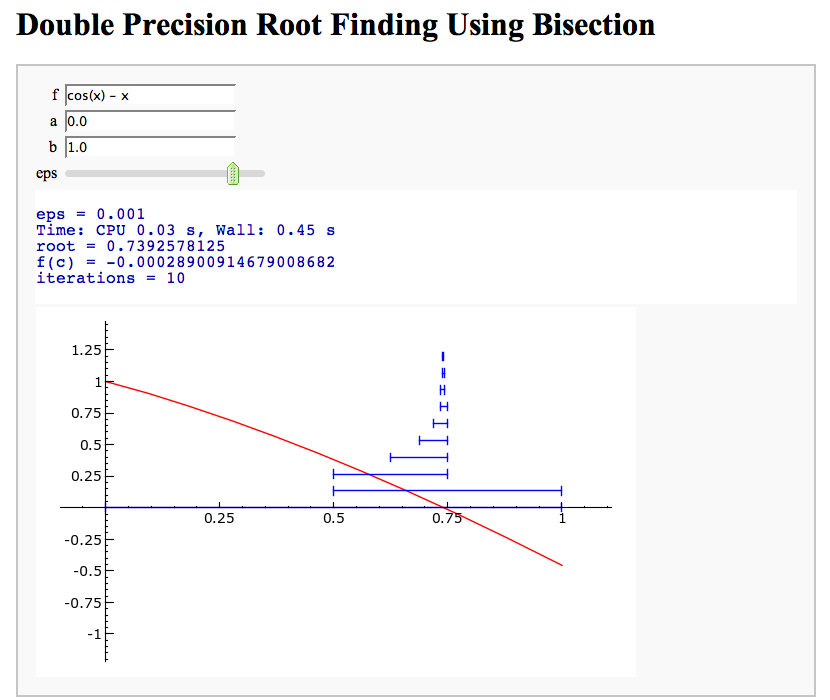
Newton's Method
Note that there is a more complicated Newton's method below.
by William Stein
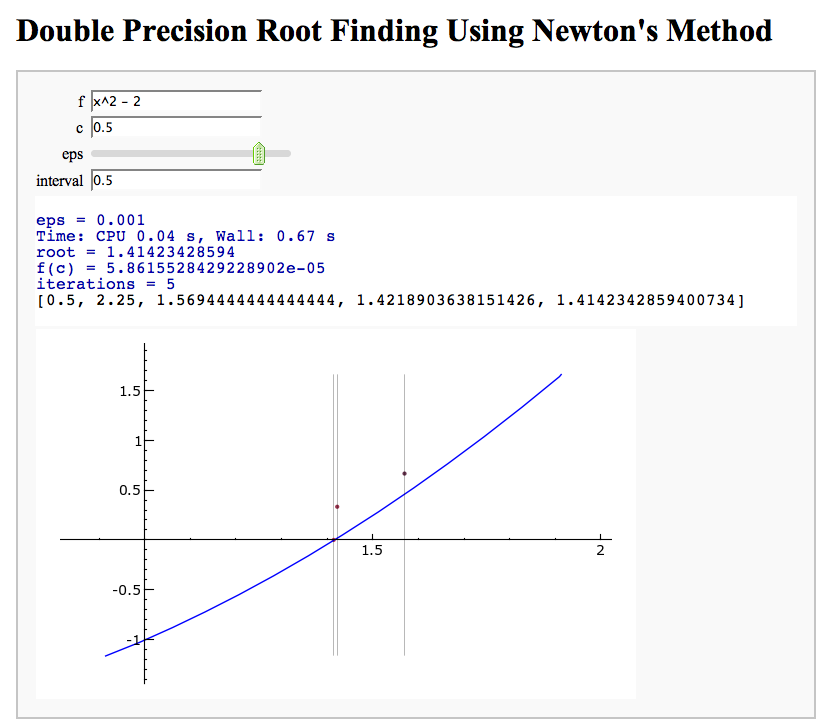
A contour map and 3d plot of two inverse distance functions
by William Stein
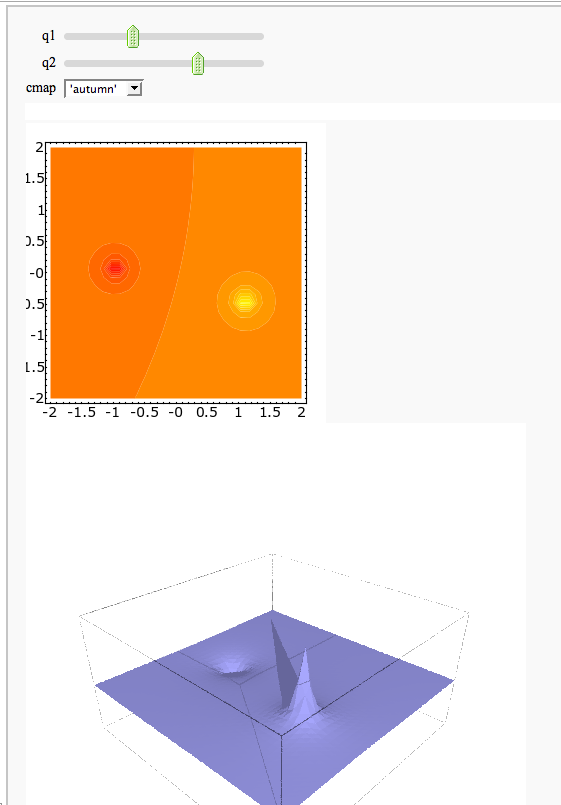
A simple tangent line grapher
by Marshall Hampton

Numerical integrals with the midpoint rule
by Marshall Hampton

Numerical integrals with various rules
by Nick Alexander (based on the work of Marshall Hampton)
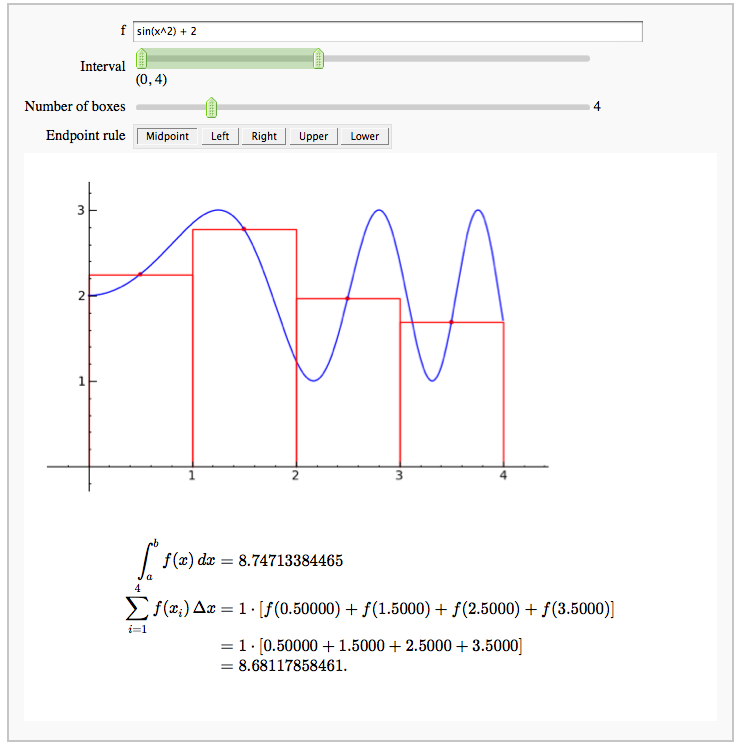
Some polar parametric curves
by Marshall Hampton. This is not very general, but could be modified to show other families of polar curves.
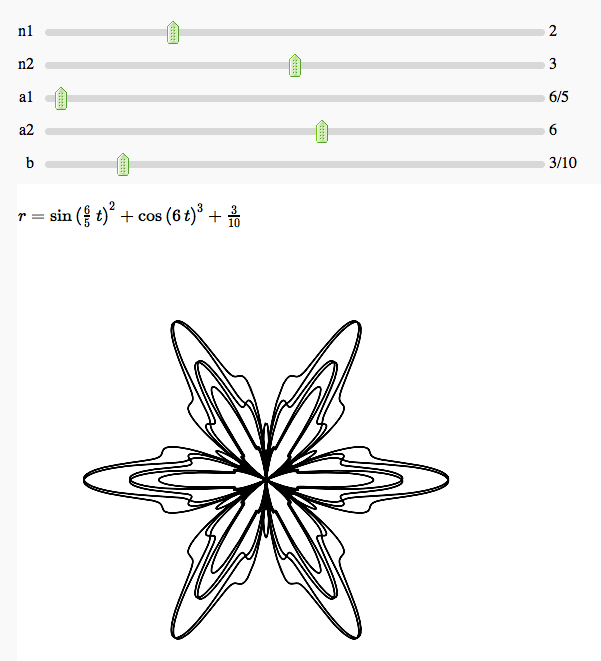
Function tool
Enter symbolic functions f, g, and a, a range, then click the appropriate button to compute and plot some combination of f, g, and a along with f and g. This is inspired by the Matlab funtool GUI.
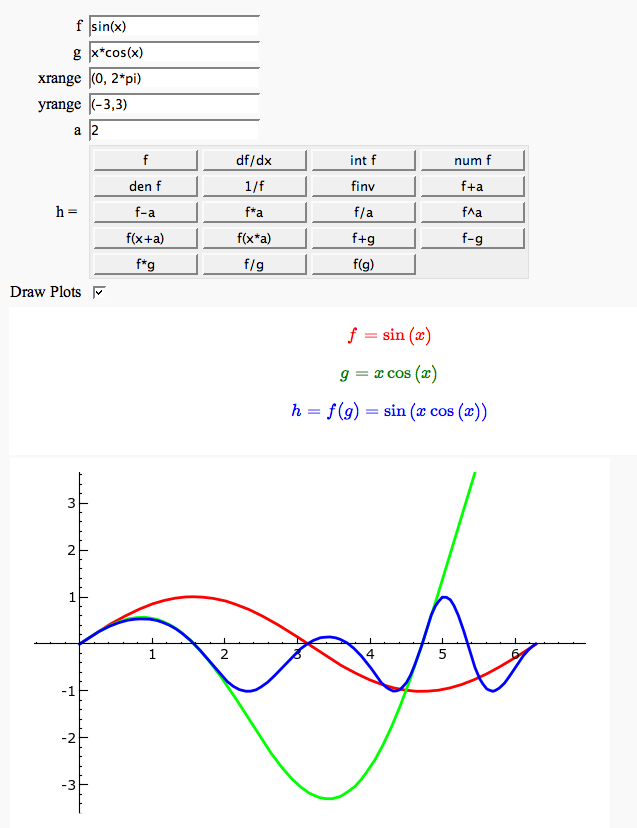
Newton-Raphson Root Finding
by Neal Holtz
This allows user to display the Newton-Raphson procedure one step at a time. It uses the heuristic that, if any of the values of the controls change, then the procedure should be re-started, else it should be continued.
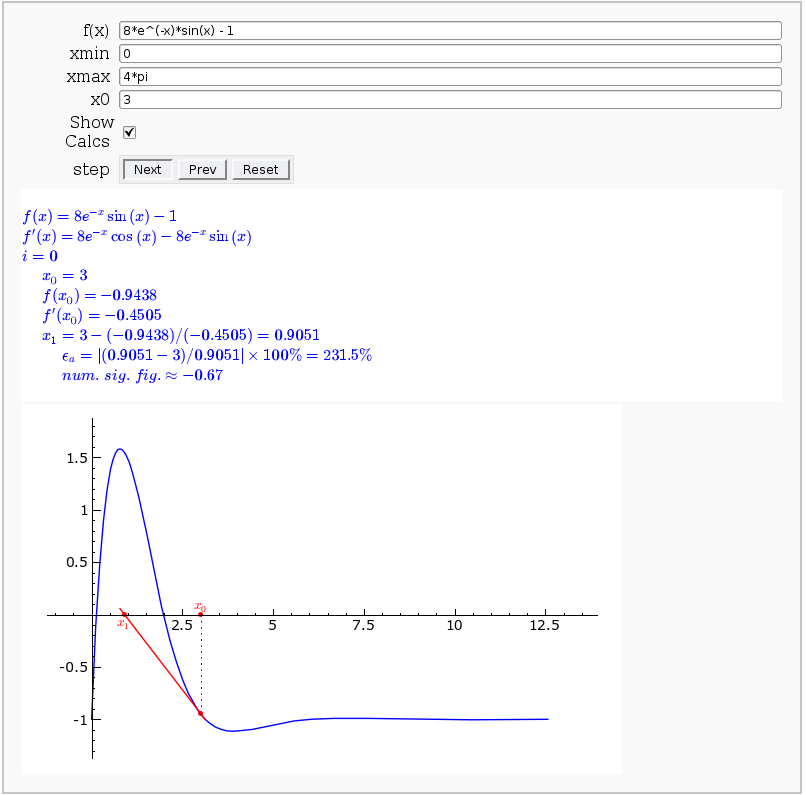
Coordinate Transformations (FIXME in Jupyter)
by Jason Grout
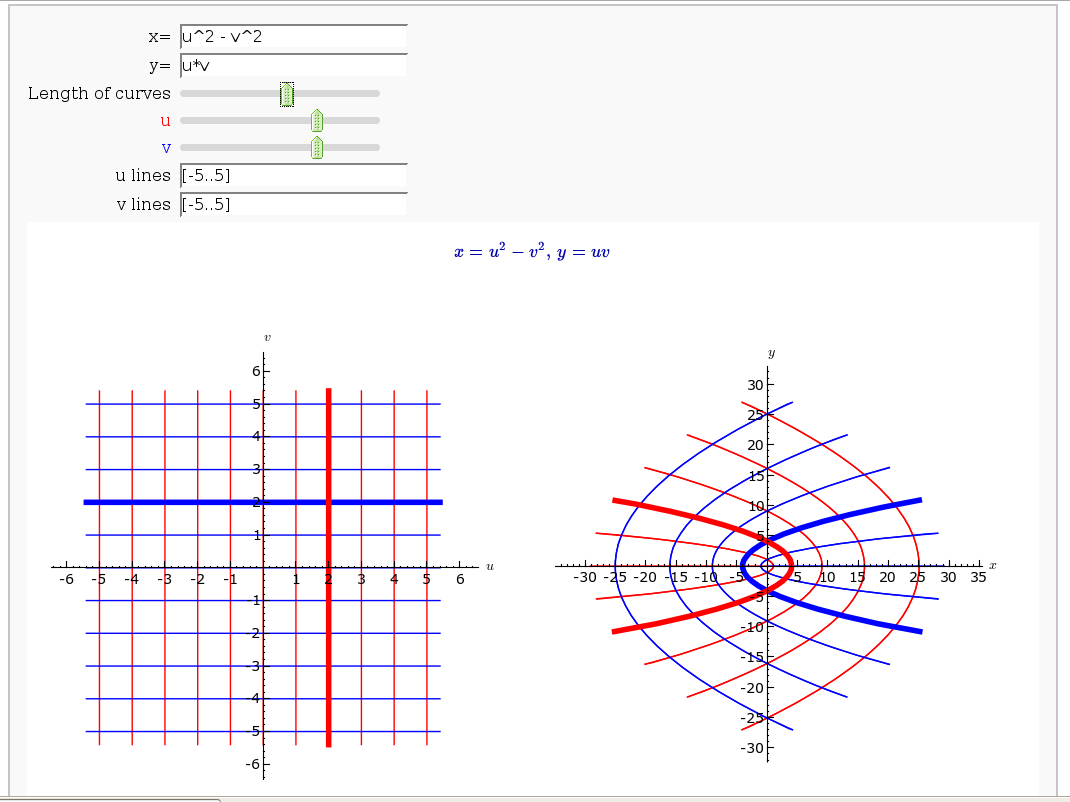
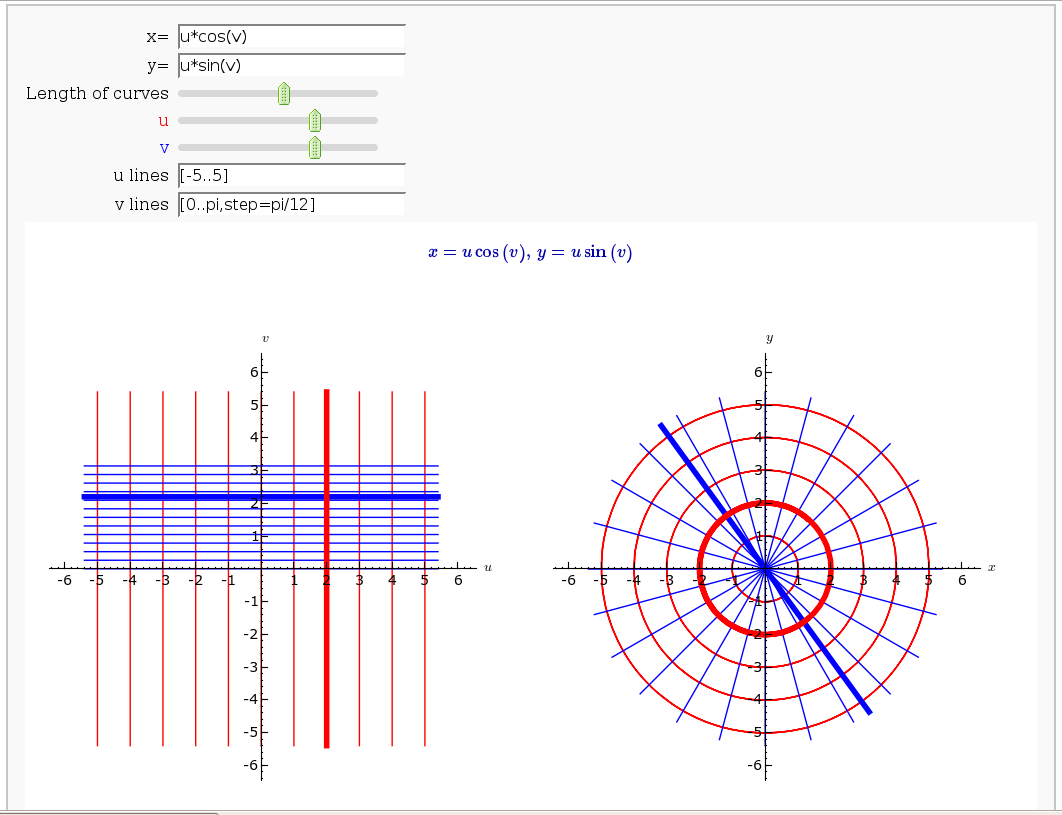
Taylor Series
by Harald Schilly
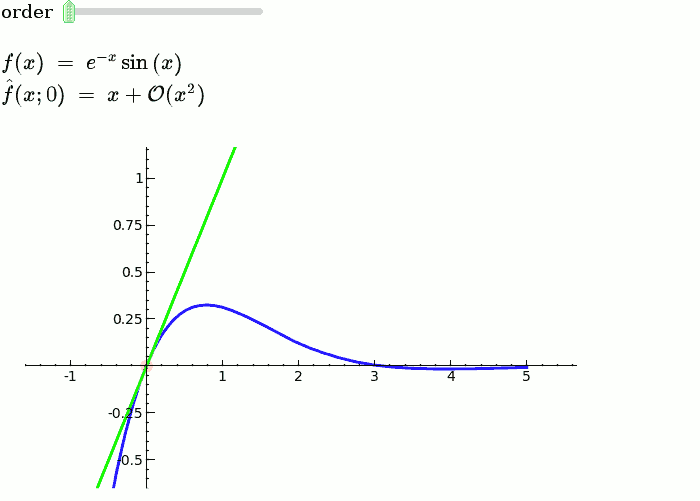
Illustration of the precise definition of a limit
by John Perry
I'll break tradition and put the image first. Apologies if this is Not A Good Thing.
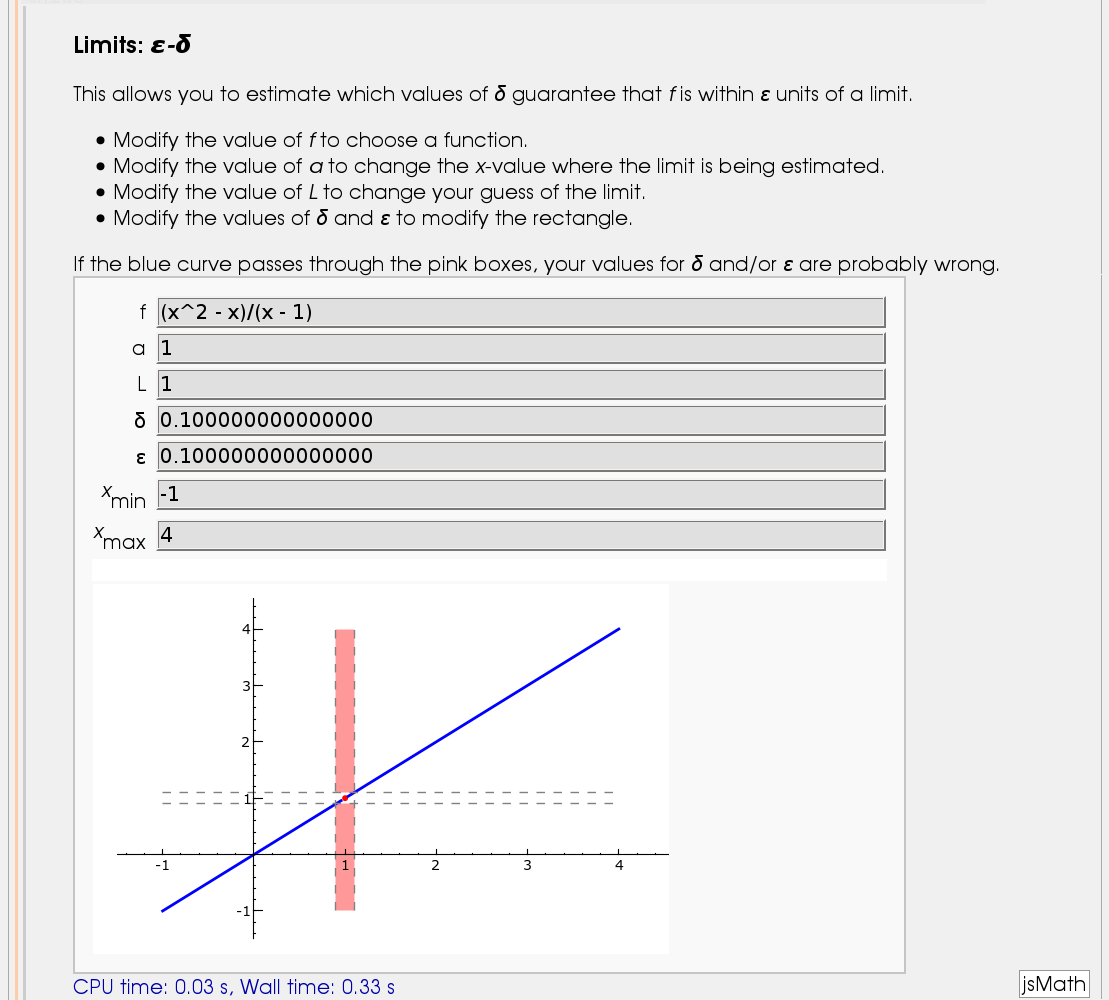
A graphical illustration of sin(x)/x -> 1 as x-> 0
by Wai Yan Pong
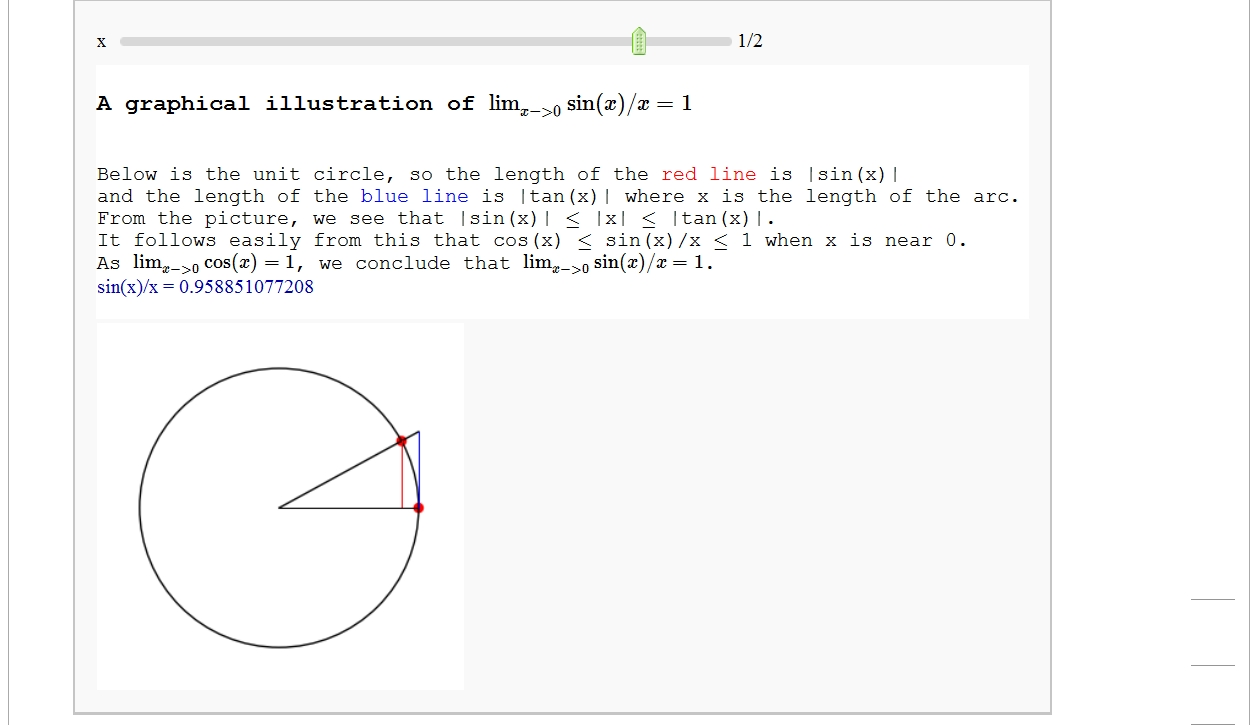
Quadric Surface Plotter
by Marshall Hampton. This is pretty simple, so I encourage people to spruce it up. In particular, it isn't set up to show all possible types of quadrics.

The midpoint rule for numerically integrating a function of two variables
by Marshall Hampton

Gaussian (Legendre) quadrature
by Jason Grout
The output shows the points evaluated using Gaussian quadrature (using a weight of 1, so using Legendre polynomials). The vertical bars are shaded to represent the relative weights of the points (darker = more weight). The error in the trapezoid, Simpson, and quadrature methods is both printed out and compared through a bar graph. The "Real" error is the error returned from scipy on the definite integral.
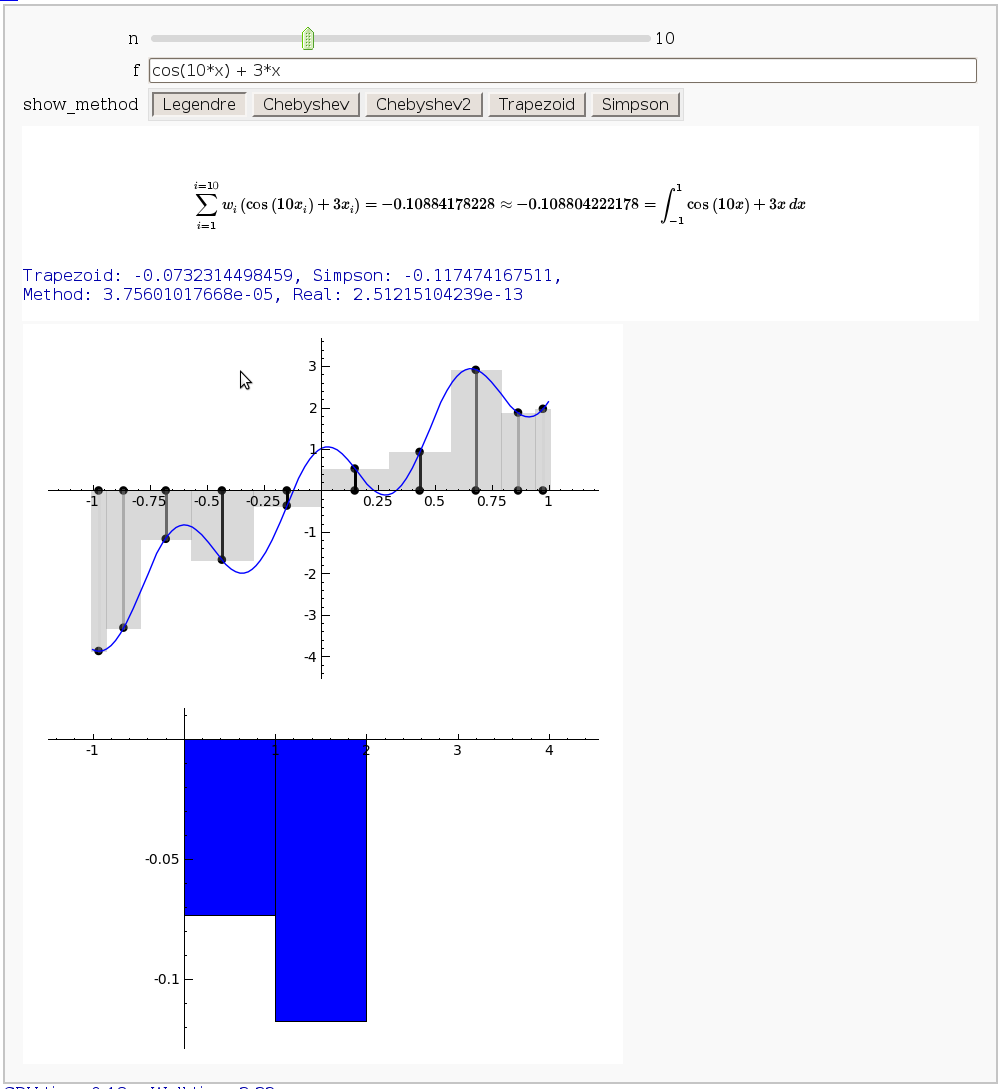
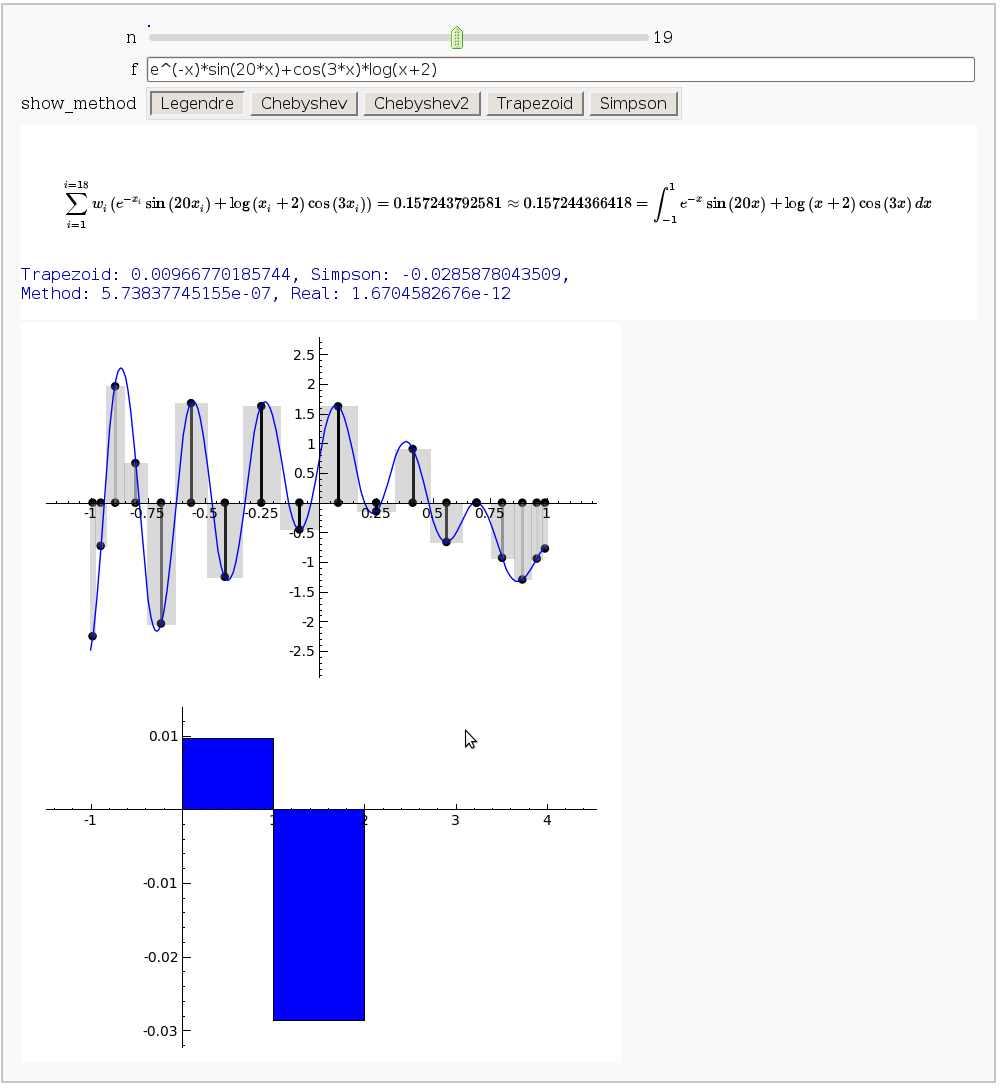
Vector Calculus, 2-D Motion
By Rob Beezer
A fast_float() version is available in a worksheet
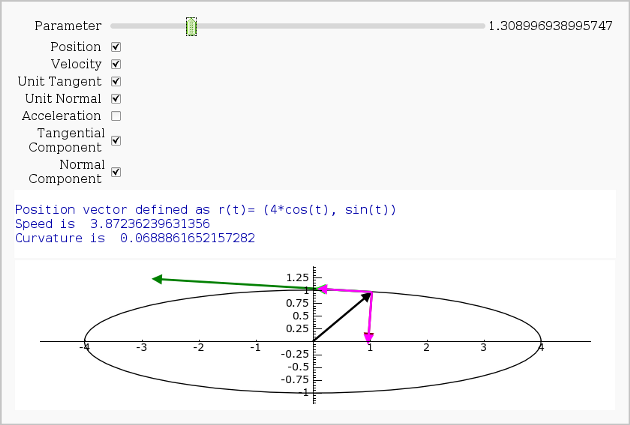
Vector Calculus, 3-D Motion (FIXME)
by Rob Beezer
Available as a worksheet
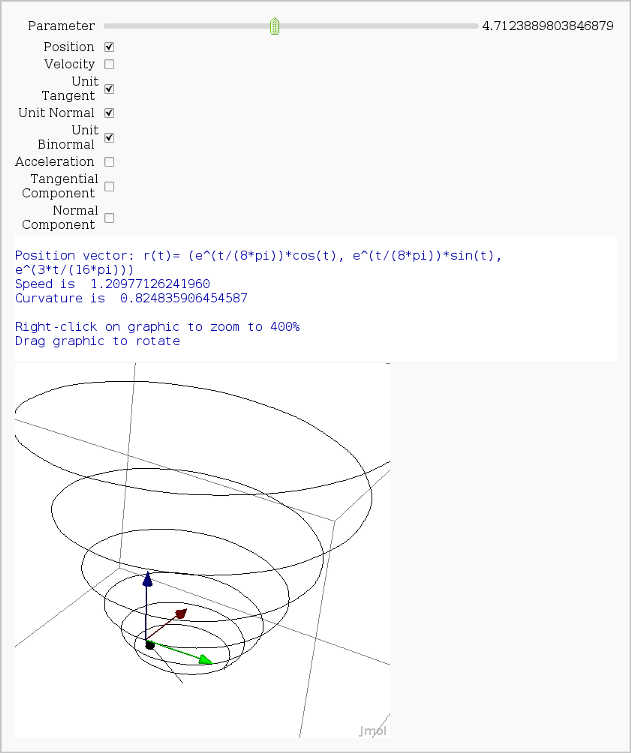
Multivariate Limits by Definition
by John Travis
http://sagenb.mc.edu/home/pub/97/
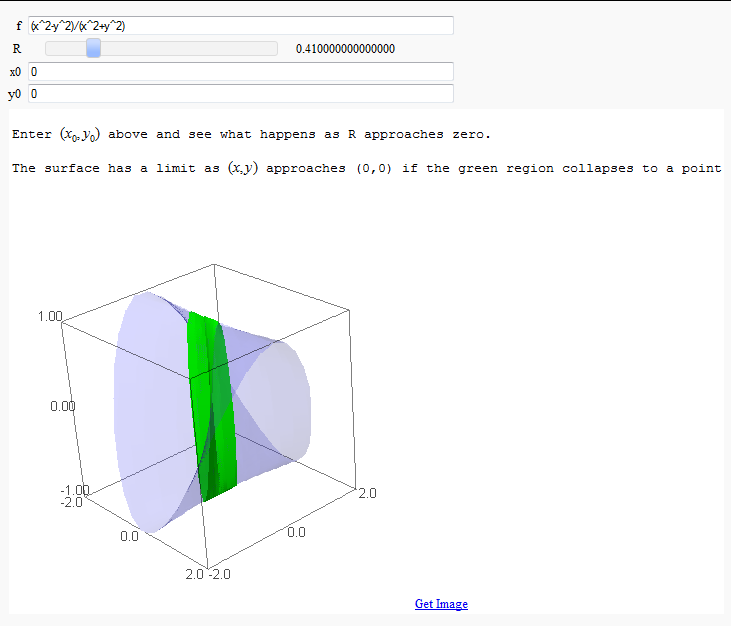
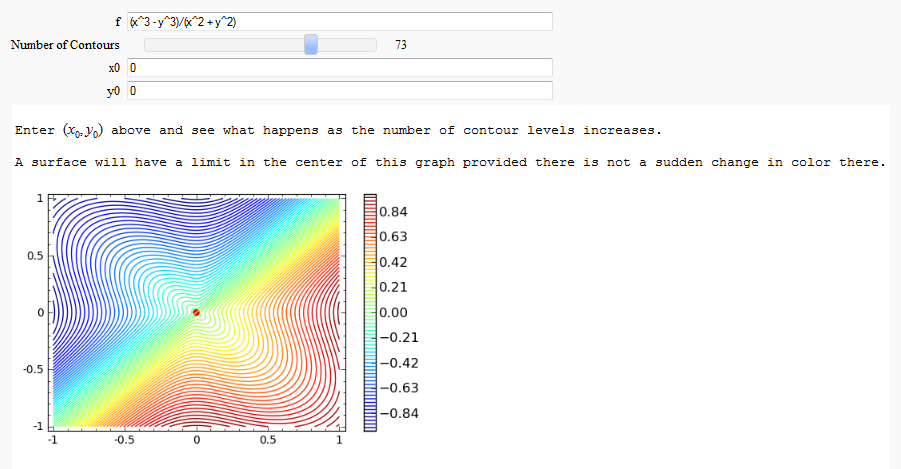
Directional Derivatives
This interact displays graphically a tangent line to a function, illustrating a directional derivative (the slope of the tangent line).
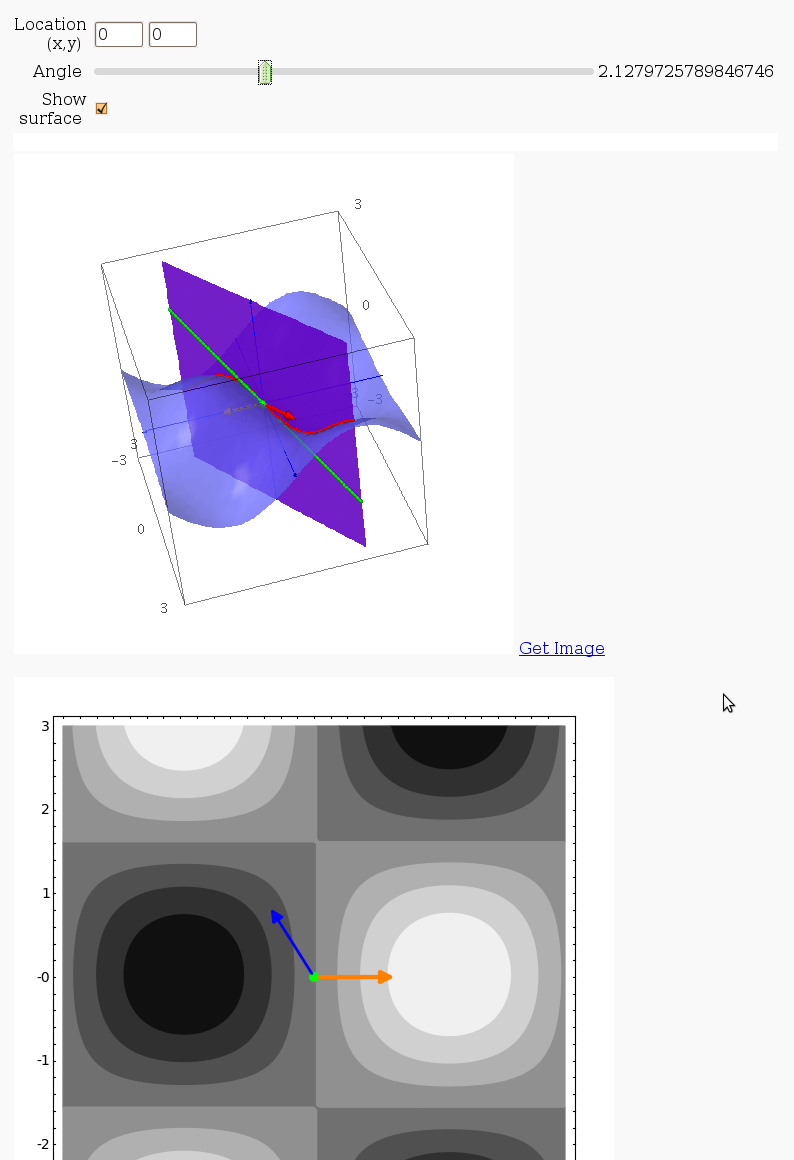
3D graph with points and curves
By Robert Marik
This sagelet is handy when showing local, constrained and absolute maxima and minima in two variables. Available as a worksheet

Approximating function in two variables by differential
by Robert Marik
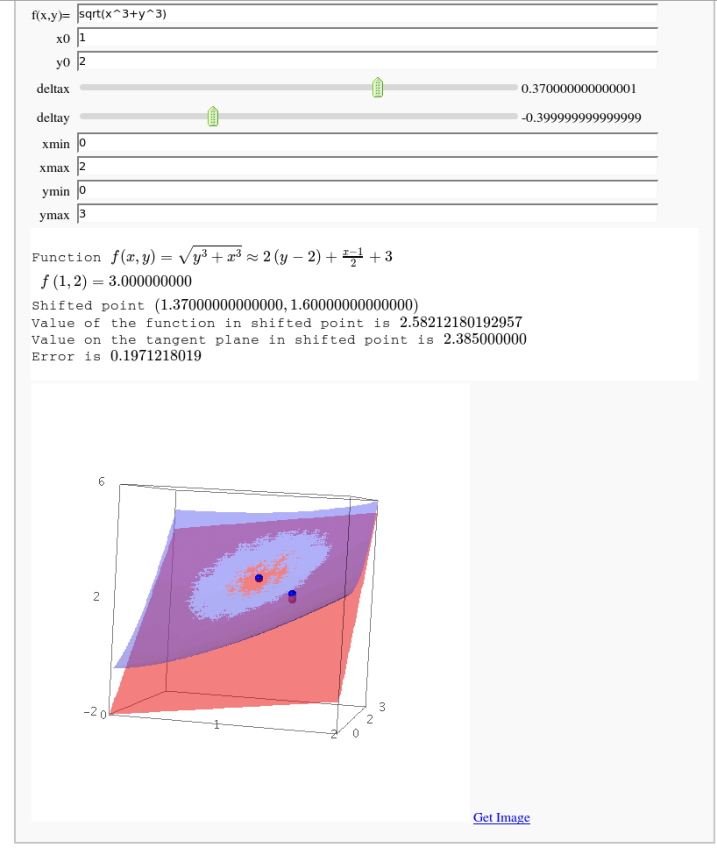
Taylor approximations in two variables
by John Palmieri
This displays the nth order Taylor approximation, for n from 1 to 10, of the function sin(x2 + y2) cos(y) exp(-(x2+y2)/2).
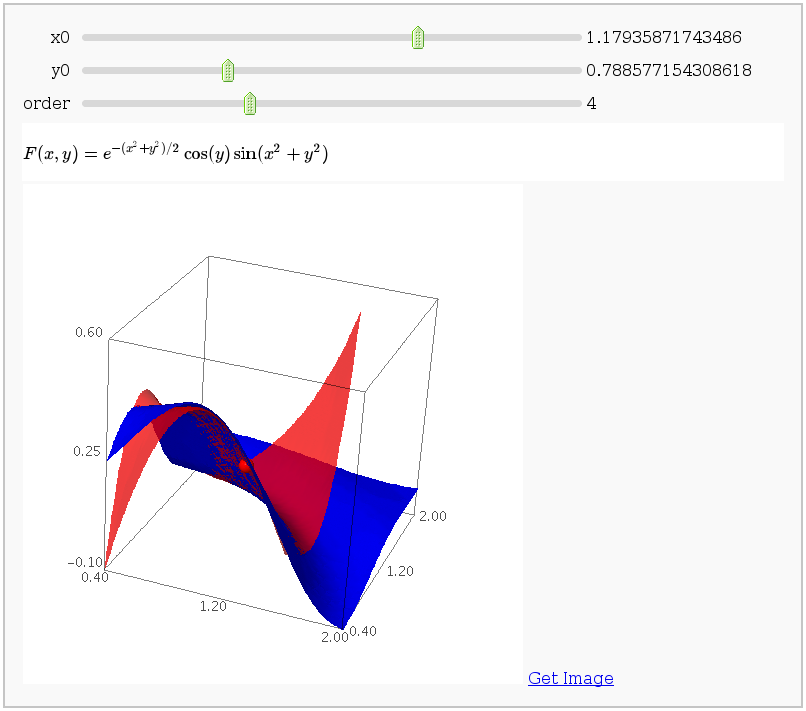
Volumes over non-rectangular domains
by John Travis
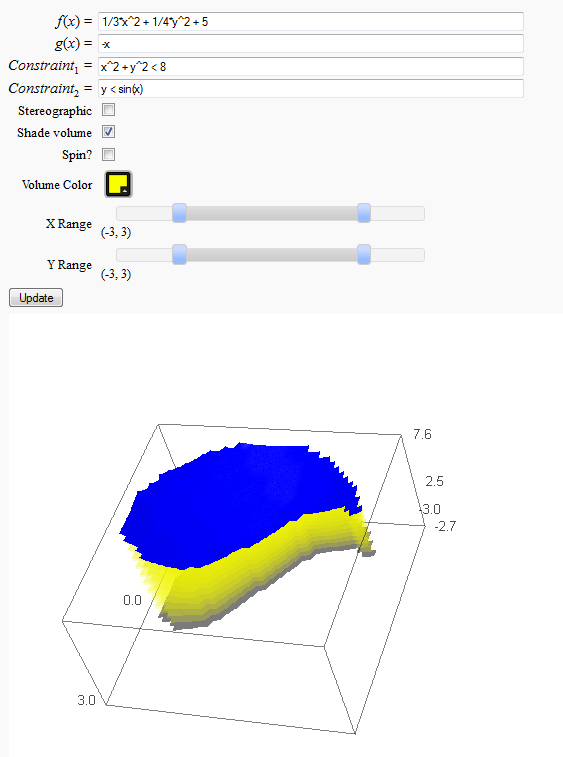
Lateral Surface Area (FIXME in Jupyter)
by John Travis
http://sagenb.mc.edu/home/pub/89/
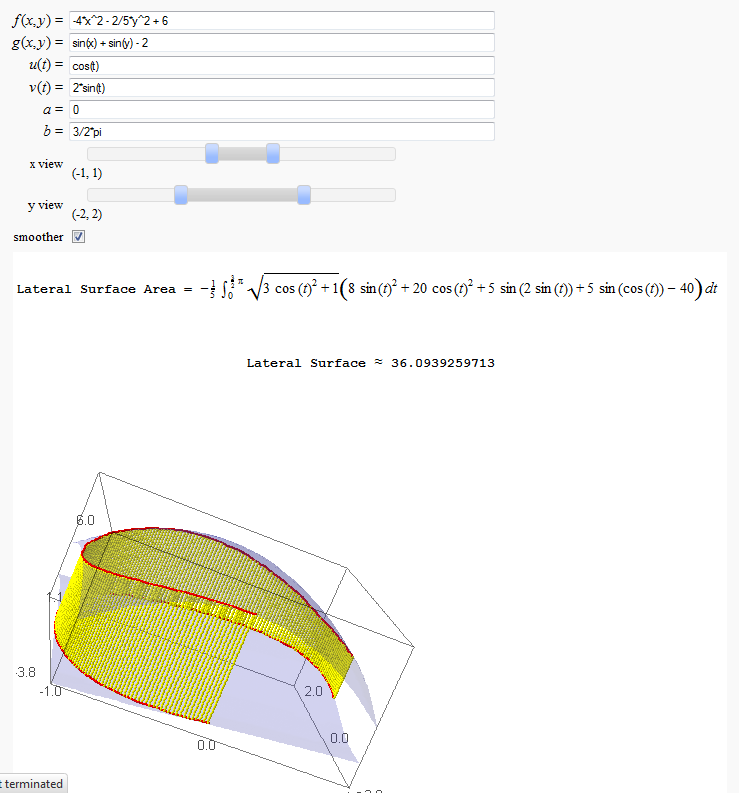
Parametric surface example (FIXME in Jupyter)
by Marshall Hampton
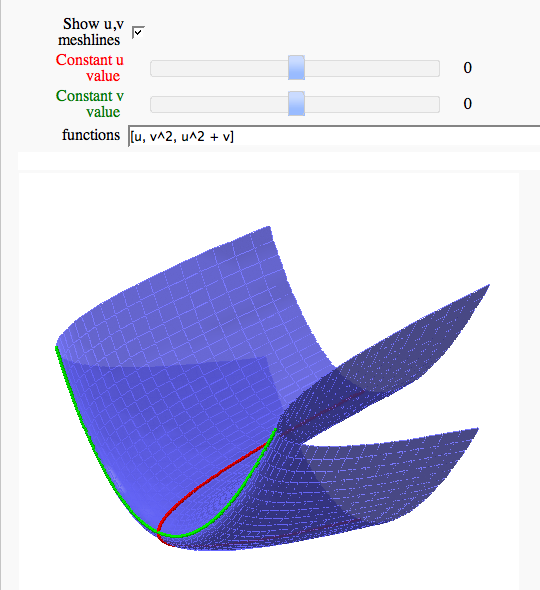
Line Integrals in 3D Vector Field
by John Travis
